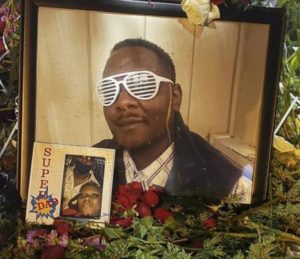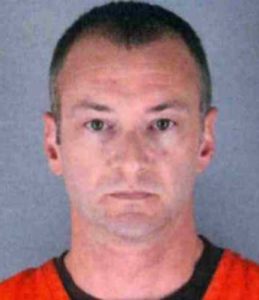 Is it more okay if the bystander is black?
Is it more okay if the bystander is black?
On July 20, 2020, Leneal Frazier (photo, left) was tee-boned by a Minneapolis cop chasing a stolen vehicle.
His Jeep cartwheeled into a bus shelter. Paramedics pried him out of the mangled wreckage, gently loaded him on a gurney, and transported him to a hospital, where he either died or a doctor officially pronounced the obvious fact he was dead. (Read story here; additional details here.)
Frazier, 40, had the green light. The cop had his blue flashers and siren going, but approached the intersection at 90 mph, which didn’t give Frazier a whole lot of perception, recognition, and reaction time. Not enough, as it turned out. True, the cop slowed a bit, but not enough; he was doing 78 mph at impact. (To get a sense of how fast that is, watch the video below.)
The cop, Brian Cummings (photo, below right), 37, was pursuing a Kia Sportage. (I didn’t know Kias could go that fast.) How exigent was the situation, how important that Cummings catch up with the fleeing vehicle at all costs? NBC News says the Kia was “suspected” of being stolen and the driver had been “involved in thefts from businesses” that “involved ‘some limited use of force’ but no weapons or injuries.” I’d rate that as “Low to Medium.”
 I mention this because you could argue, with some reasonableness, that a cop may be justified in taking more risks with the safety of the general public if he’s pursuing, say, a drunk driver going the wrong way on a freeway who’s likely to kill someone if he isn’t stopped, or a car with a kidnapped child in it (although in that case, is it wise to give chase, causing the driver to flee at 90 mph?).
I mention this because you could argue, with some reasonableness, that a cop may be justified in taking more risks with the safety of the general public if he’s pursuing, say, a drunk driver going the wrong way on a freeway who’s likely to kill someone if he isn’t stopped, or a car with a kidnapped child in it (although in that case, is it wise to give chase, causing the driver to flee at 90 mph?).
And, needless to say, crashing into Frazier’s Jeep was counterproductive; Cummings didn’t catch the Kia. Instead, he caught a ride to a hospital. (News reports don’t say whether his injuries were serious or minor.)
All police departments have vehicle chase policies. These policies vary among police agencies, and sometimes are controversial, usually after someone gets killed as in this case. (NBC News reported that “Minneapolis Mayor Jacob Frey promised a review of the police pursuit policy after Frazier was killed.”) If the cop went by the book, the city apologizes for the accident, pays the family a couple million bucks, and talks about what could have been done differently in training classes.
If the cop didn’t follow those policies, he’s effed. In this case, the prosecuting attorney reviewed the incident, accused Cummnings of “culpable and gross negligence,” and charged him with manslaughter and vehicular homicide.
(Article continues below diagram)
There are countless police chase dashcam vids on YouTube, so many you can become a chase junkie if you want to, and even something of an expert; and what you’ll see is that almost invariably the pursuing cop slows down approaching intersections. So I’ve gotta believe that’s a pretty standard police policy.
Another thing you’ll see is other police cars joining the chase. There’s no need for a given pursuing officer to catch up with the suspect vehicle, all he has to do is tell the dispatcher where it’s heading, and even if he does catch it he usually can’t stop it by himself. Ending pursuits almost always takes a team effort, often entailing use of spike strips, PIT maneuvers, and/or boxing in the suspect. And car chase suspects often try to flee on foot, and it takes multiple officers to corner them and run them to ground. Cops are trained in all of this.
Life isn’t risk-free. We all know that. You can get killed driving to work. But cops are supposed to keep us safe, not put us in danger. Most people recognize unreasonable risk-taking when they see it. The video below played a role in the prosecutor’s decision to charge Cummings with criminal homicide for smacking into Frazier’s Jeep at high speed. Ultimately, it’ll be for a jury to decide whether he caused an accident (penalty: pay money to victim’s family) or committed a crime (penalty: go to prison).
Frazier was black. Will that influence the outcome of Cummings’ trial? Should it? Certainly, there’s a sense among many Americans, and especially among Minneapolis’ black population, that black lives are cheap and expendable in the eyes of the police. In this case, it doesn’t help that Frazier was an uncle of the girl who made the now-famous tape of Derek Chauvin murdering George Floyd.
But there’s no way Cummings possibly could have known that the driver of the vehicle he was about to collide with was black and closely related to someone who played a key role in the George Floyd case. It’s not even reasonable to assume he knew that he was about to hit another car; at most, he would have known he might hit something, but decided to risk it anyway, either because he thought the risk was minimal, or decided it was worth taking to catch the Kia.
The thing is, not only will the jury weigh these things, but all of society will. There’s no way this debate doesn’t spill out of the courtroom into the news media, commentaries, and larger society including citizens on the street. And what it boils down to is: Is it okay for cops to put innocent bystanders at risk, sometimes very substantial risk, in order to catch a bad guy? What if a bystander gets killed? What if you get killed?
Is it more acceptable if the bystander is black, and not you?
